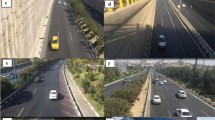Abstract
In 2001, there were 3,638 traffic accidents on the freeways of Korea, with 54.2 percent composed of vehicles that crashed into longitudinal barriers. Such accidents can be drastically reduced if more safe barriers are installed for traffic safety. A small Korean manufacturing company invented a new concept longitudinal barrier, the Rolling Barrier (RB), which has continuous pipes covered with urethane rings. This study aims to evaluate the effectivenes of the RB, and to understand the RB's characteristics of crash cushioning, how to correct the vehicle's running direction, and the required strength of barriers. Experiments with barrier performance and crashing vehicle behavior at curved sections using a 1.3-ton passenger car and a 3.5-ton truck showed satisfactory vehicle behavior as they ran parallel with the RB after crashing. The structural problem of the RB was not found during the time of the crash. In the strength performance test using the 8-ton truck and in the passenger protection test using the 1.3-ton passenger car, the RB satisfied the Ministry of Construction and Transportation's “Guidelines for Installation and Managemetn of Road Safety Facilities.” The differences between the RB and conventional barriers where crash cushioning and required strength of barriers were involved were verified by mathematical equations. The RB can be effectively used in curved road sections, ramps, medians, and entrance/exit ramps in parking garages.
Similar content being viewed by others
References
Geodo Industry Cop. (2000). “A Study on the Protection Performance of Rolling Barrier Systems.” Busan, Korea.
Geodo Industry Cop. (2003). “Application for new techniques: Manufacturing and installation techniques of the Rolling Barrier, which activates rolling friction.” Busan, Korea.
Michie, J.D. (1980). “Recommended Procedures for the Safety Performance Evaluation of Highway Appurtenances.” NCHRP Report 230, TRB, Washington, D.C.
Serway, R.A. and Beicher, R.J. (2000).Physics for Scientists and Engineers, 4th Edition. Thomson Learning. pp. 126.
Author information
Authors and Affiliations
Corresponding author
Rights and permissions
About this article
Cite this article
Kim, KW., Shin, BY. A study on the characteristics of rolling barriers. KSCE J Civ Eng 8, 135–139 (2004). https://doi.org/10.1007/BF02829089
Received:
Accepted:
Issue Date:
DOI: https://doi.org/10.1007/BF02829089




